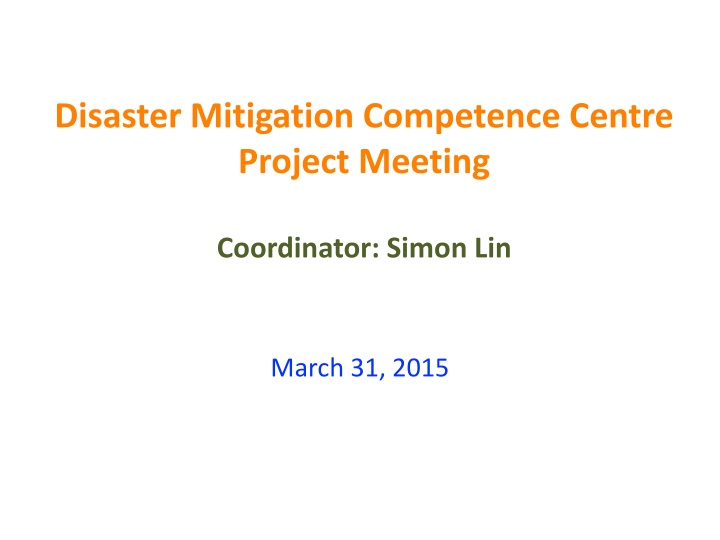
Disaster Mitigation Competence Centre Project Meeting Coordinator Simon Lin
The Disaster Mitigation Competence Centre Project, led by Meeting Coordinator Simon Lin, focuses on improving disaster prevention strategies through e-Science, simulation, and collaboration. Goals include enhancing prediction accuracy and conducting simulations of combined disaster scenarios.
Download Presentation

Please find below an Image/Link to download the presentation.
The content on the website is provided AS IS for your information and personal use only. It may not be sold, licensed, or shared on other websites without obtaining consent from the author. If you encounter any issues during the download, it is possible that the publisher has removed the file from their server.
You are allowed to download the files provided on this website for personal or commercial use, subject to the condition that they are used lawfully. All files are the property of their respective owners.
The content on the website is provided AS IS for your information and personal use only. It may not be sold, licensed, or shared on other websites without obtaining consent from the author.
E N D
Presentation Transcript
Disaster Mitigation Competence Centre Project Meeting Coordinator: Simon Lin March 31, 2015
Agenda Partners Contributions & Refined Project Plan M12: Tsunami and Weather Simulation Environmental Computing Workshop Future Events and Next Meeting AOB
Goals: e-Science for the Masses Objectives: improving strategy of prevention and reduction of disasters By better knowledge of the Earth s physical phenomena, we can mitigate the consequences of similar disasters in the future. Advancement of prediction accuracy on target disasters Approaches By estimating the natural hazards at a given site or by means of early warning systems, or forecasting the occurrence of the eventually generated disaster after the next strong events. Buildup the close collaboration of domain experts, e-Science service providers and e-infrastructure resource centers. Construct fast and accurate simulation by taking advantage of the domain knowledge and the e-Sciences Conduct simulation of combined disasters scenarios to verify the effectiveness of our design on potential cases
1. Earthquake & Tsunami (I) Background Knowledge of past tsunamis is critical in identifying potential tsunami sources, understanding the focal mechanism, and developing mitigation plans Tsunami wave propagation simulation is essential to disaster warning and estimation Tasks Potential tsunami scenarios identification: Manila Trench, Sunda Trench: PH, ID, VN, TW Tsunami Wave Propagation Simulation Web Portal: ASGC Historical Tsunami Records Collection and Inversion Simulation to identify potential tsunami sources: PH, ID, VN, TW Immersive visualization: LMU Simulation Web Portal iCOMCOT web portal Services: http://icomcot.twgrid.org Milestone
1. Earthquake & Tsunami (II) Excellence Towards Real and Complex Disaster Scenario simulation Earthquake tsunami Spotting potential tsunami sources for better preparedness Correlation analysis between initial surface and the earthquake rupture characteristics from historical tsunamis Milestone M4: Collect historical tsunami records: PH, VN, ID, TW Find local earthquake/tsunami scientists to design the disaster scenario and try the iCOMCOT system: PH, VN, ID, TW M10: Finish at least one forward simulation by the designed scenario. Finish at least one inversion simulation by the collected historical tsunami event. Result evaluation: functionality, workflow, performance, accessibility, etc. M12: iCOMCOT system revision based on the evaluation M18: finish two high risk tsunami subduction zones scenario analysis
2. Extreme Weather (I) Background Understanding and simulating mesoscale weather processes such as typhoon, dynamic interactions between typhoon circulation and monsoonal flow at different scales Enhance the forecasting capability in precipitation events brought by similar events Tasks Investigate historical extreme weather event: KR, PH, VN, TH, MY, ID, TW WRF (Weather Research and Forecast) simulation web portal: TW Immersive Visualization: LMU
2. Extreme Weather (II) Excellence Improve the understanding of multi-scale nature of tropical cyclones for generating local heavy rainfall events Fast and accurate simulation could enhance the early warning Milestone M3: Collect data of at least one target extreme weather event by engaging local user communities M6: Investigate the first simulations of the mesoscale processes: e.g., water vapor, moisture flux, etc. M9: Result evaluation M12: Refine the WRF web portal
3. UHI and Asian Dust Transportation (I) Background Understanding the impacts of long-range dust transportation in Asia Pacific region Understanding the impacts of urbanization to the local weather Tasks Finish at least one case study of long-range dust transportation in Asia (either volcanic ashes dispersion or biomass burning): PH, MY, TH, ID, TW Finish at least one case study of urban heat island among partners: KR, PH, MY, TH, ID, TW Buildup the modeling and simulation capability of UHI and dust transportation Immersive Visualization: LMU
3. UHI and Asian Dust Transportation (II) Excellence Provide seasonal variations analysis of CO, O3and PM10, including the concentration, transportation path and climate impacts, etc. Buildup impact analysis capability of the Urban Heat Island effect on precipitation over a complex geographic environment Milestone M13: confirm the target case and review the data collected (at least one event for ADT and UHI respectively) M16: first simulation investigation M20: case analysis and refined simulation M24: finish the workflow, data analysis, simulation and the web portal
Next Meeting & Future Events April 14: Progress Checking April 28: Progress Checking May 12: Progress Checking May 18-22, EGI Conference, Lisbon, PT Aug. ?, APAN ?, Kuala Lumpur, MY Environmental Computing Workshop, ISGC 2016





















